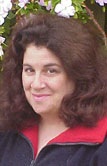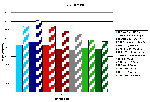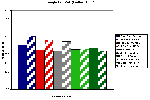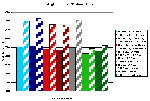September 2002 Article Tennis Server
|

 |
Ball/Court Interaction - Part I
Ball physics studies would certainly be a lot simpler if we could narrow the variables down - for example, just count the ball spin (which has its own unique issues). However, the majority of ball physics studies must monitor a multitude of simultaneously changing factors to obtain results. Such is the case with ball/court interaction studies. Aside from environmental factors and atmospheric conditions like wind, altitude, temperature, humidity and air pressure, the ball's trajectory after its bounce is affected by:
Why examine ball/court interaction at all? These components affect the angle and velocity off of the court, the distance the ball travels after the bounce and the maximum rebound height. With a variety of court surfaces available, ball/court interaction affects the amount of time you have to get to the ball and the height the racquet can approach and strike the ball. If you have played on a variety of surfaces you know grass courts are considered "fast" (you typically have less time to get to the ball and the angle after the bounce is typically low) and clay courts are "slow." Hard court speeds are somewhere in between. As a guideline, what results would we expect? According to Professor Howard Brody's book, Tennis Science for Tennis Players, friction between the ball and the court:
In a study done as part of a cooperative educational project between NASA Ames Research Center and Cislunar Aerospace, Inc. ball/court interaction affects were investigated. High speed cameras captured ball action at 250 frames per second. Balls were marked with a black line around the ball's circumference so spin rates could be examined. Different types of spin and rates of spin (flat, low topspin, medium topspin, high topspin, medium underspin and high underspin) and four court surfaces (hard, red clay, green clay and grass) were used in this investigation. Wilson "US Open" balls were used on each court. In addition, court specific balls (Wilson clay court balls on the green clay, Roland Garros balls [the French Open ball] on the red clay and Slazenger [Wimbledon] balls for the grass court) also were tested. A ball machine able to control ball spin and speed was used to launch the balls. Results - Angles Before And After The Bounce Results for flat (no spin) balls are summarized below. (You can click on the graphs for larger versions).
Is this what we expected? Yes! Notice the difference between the rebound angle and the angle before the bounce. We expect grass to be fast and clay to be slow. The grass surface has a tendency to let the ball skid. The trend we expected and observed with the flat (no spin) continues with the topspin. Based on the difference between the angle in and angle out, grass is fastest by far, than the hard court and then the clay courts. However, there are some major differences. As the spin rate increases, the difference in the angles out is decreasing. While the angle out was always greater than the angle in for the flat (no spin) case, that trend disappears for the grass court with medium topspin. For heavy topspin, the angle out is significantly lower than than angle in. Looking at the other courts - red and green clay and the hard court - as the spin rate increases, the angle before the bounce is almost identical to the angle out. Determining the fastest court speed based on these numbers is no longer as easy as it was for the no spin case.
Low Topspin - All Courts
Heavy Topspin - All Courts
Average Angle In and Angle Out
In analyzing the underspin results, it was important to remember that after the bounce the ball would have topspin. Although it is observed from time to time, the majority of underspin balls change direction into topspin after the bounce. While balls with no spin or topspin before the bounce will naturally follow the direction of flight and generate topspin after the bounce, balls with underspin before the bounce change spin direction after the bounce and have topspin.
There are several interesting observations to make:
Why would the grass court behave differently? Unlike the slower courts the grass surface allows the balls to skid. There is less friction and interaction between the ball and the grass court. In Part II of this article, we'll look at how these angles affect the height and distance of the ball's trajectory after the bounce and the amount of time this gives you to get to the ball. Until Next Month ... Jani References Brody, H., Tennis Science For Tennis Players, University of Penn. Press, 1987. Cislunar Aerospace, Inc., wings.avkids.com/Tennis, 1997-2002. Acknowledgement to NASA Ames Research Center for their assistance through agreements NCC2-9010 and NCC2-9014.
This column is copyrighted by Jani Macari Pallis, Ph.D., all rights
reserved.
Dr. Jani Macari Pallis is the founder and CEO of Cislunar Aerospace,
Inc., an engineering and research firm in San Francisco. In addition
to her engineering practice, she has led two collaborations between
NASA and Cislunar, creating educational materials on the aerodynamics
of sports for pre-college students and educators. As the head of
NASA's "Aerodynamics in Sports" project, she has led a team of
researchers investigating the aerodynamics, physics and biomechanics
of tennis. The group has conducted high speed video data capture at
the US Open and research of ball/court interaction, footwork, serve
speeds, trajectories and ball aerodynamics. Pallis received a BS and
MS from the Georgia Institute of Technology, an MS in mechanical
engineering from the University of California, Berkeley and a Ph.D.
in mechanical and aeronautical engineering from the University of
California, Davis. She is a member of the Executive Committee of The
International Sports Engineering Association.
Questions and comments about these columns can be directed to Jani by
using this form.
|



October 2022 Tennis Anyone: Patterns in Doubles by John Mills. September 2022 Tennis Anyone: Short Court by John Mills. |
 You will join 13,000 other subscribers in receiving news of updates to the Tennis Server along with monthly tennis tips from tennis pro Tom Veneziano.
You will join 13,000 other subscribers in receiving news of updates to the Tennis Server along with monthly tennis tips from tennis pro Tom Veneziano. 





